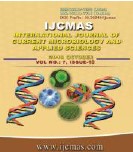


 National Academy of Agricultural Sciences (NAAS)
National Academy of Agricultural Sciences (NAAS)

|
PRINT ISSN : 2319-7692
Online ISSN : 2319-7706 Issues : 12 per year Publisher : Excellent Publishers Email : editorijcmas@gmail.com / submit@ijcmas.com Editor-in-chief: Dr.M.Prakash Index Copernicus ICV 2018: 95.39 NAAS RATING 2020: 5.38 |
Under the scenario of an escalating population and an epoch of climate variability, increasing the production of rice to confront the food security and overcome the human demands from the ever shrinking land resources have emerged as an obligatory step in augmenting the nations’ economy. Rice productivity system is subjected to wide aberrations in the economic output and identifying the impact of weather variation at different phonological events of the crop is the predominant area of concern as it may help in understanding their response in terms of final productivity and enhance the functioning of the yield predicting models. Such assessment would enable not only to understand the extent of changes in rice production which could be already occurring due to changes in historical climate, but also to identify the rice producing regions vulnerable to weather shocks. Confiscating the biotic events and other abiotic factors, meteorological elements precisely, rainfall and temperature were identified as the paramount factors invariably controlling the potential grain yield of the crop. Rise in atmo¬spheric temperature is detrimental for Asian rice as it may affect the phenology and physiology of the crop, and thereby, causing spikelet sterility, disruption of plant respiration, photosynthesis and shortening of grain-filling period, all of which leads to lower productivity. Further, extreme rainfall events during sowing and transplanting in high water table regions as well as deficit of the same at time of emergence and reproductive stage can diminish productivity.
 |
 |
 |
 |
 |